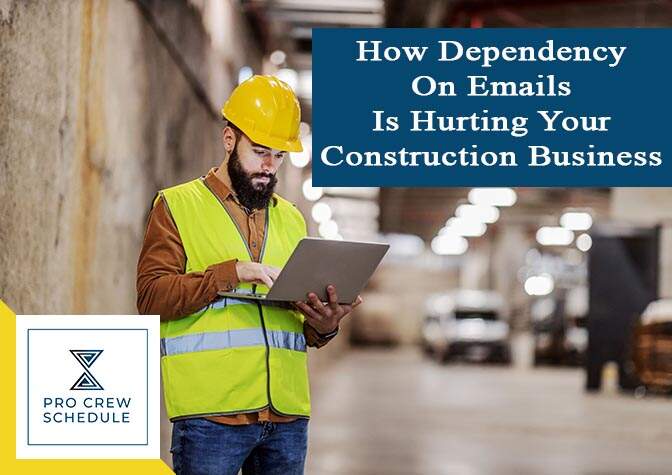What is an email? That thing you check approximately a million times a day. That thing that your construction team does even more often, the black hole that never ends- you even know the notification sound by heart now. It is the “task” that makes anyone feels oh so productive while often doing a lot of nothing.
Now, we know you have probably heard various reasons why email is pointless, a waste of precious time, and we’re not here to repeat these facts to you. Instead, here are what we are saying:
Email, for what it’s worth, is considered a groundbreaking discovery back in its time- but its reliability for companies is numbered. In 2014, research showed that email consumes 23% of an average employee’s workday and that an average employee checked their email at least 36 times an hour. As of 2020, those numbers reached 306.4 billion emails sent and received daily across the globe.
If you’re starting to understand what a cumbersome email represents and wonder whether it might be harming your construction projects, gold star. Complete dependency on email in construction may drastically fail to provide the best solution to various needs in the construction industry and outside it. In summary, email creates a system of disconnected data and information, increases human risk, and wastes time, overall decreasing a company’s productivity daily.
Plus, ponder on this question: When it comes to managing construction data and correspondence, should we trust the same tool our parents and other ancestors use to forward their spam chains letters?
In a nutshell, is email in construction ruining or dampening your projects? Let’s take a quick look at that question today and what you should be investing your resources on instead of email.
1. Email Encourages Multitasking, Productive or Not
While we tend to glorify good multitaskers, researches show that those who jump between various tasks aren’t that effective as you could hope for. Even if you turn your attention briefly to one task, you have disrupted the current flow state of the activity you are doing. This is harder for the brain to comprehend, and the “transitioning cost”–your brain’s ability to change tracks–is also higher than you might think. The simple sentence, “where was I?” is ultra-bad news, but most of us don’t even realize how time-consuming it is in reality.
The trouble is email in construction is sporadic in its very nature, offering only bits and pieces of info here and there before you must return to the task you are initially doing. The number of emails, combined with transitioning, makes email an insistent monster.
Moreover, it’s not that pleasant. Despite the dopamine boost we get through our neurons every time we see a new message, email actually pressures our psyche beyond comfortable tolerance. Email increases multitasking, fragments our attention, and contributes to the feeling that there is too much to do but not enough time to do it.
2. Email Don’t Foster Accountability
It’s true that in simple, “you do this, and I’ll do that” email chains we see every day, our electronic mail can provide useful accountability to a construction team.
Much of the time, however, email creates unnecessary confusion and uncertainty. The habits of sending, forwarding, cc’ing, bcc’ing, and replying to long chains can quickly add up and become unmanageable. Once you add in features and built-in extensions meant to make email workflows more convenient and pleasing, emails become too complicated that no one has the time, willingness, and energy to untangle. Hence, accountability remains unclear.
It’s often a lot like playing a game, too, with the original message changing each time slightly. One can usually start a new email thread, forwarded it to different people, therefore losing the initial context and people looped in the email chain, leaving everyone in the dark.
3. Email Drains A Huge Chunk of Employees Time
Remember earlier when we said that an average employee spends nearly one-quarter of their time on email? Well, that one is something we couldn’t highlight any better. Between multitasking and trying to promote accountability from monstrous email chains, it’s a huge time sucker.
That’s even before you account for the other time sinks present in the email, such as finding and referencing old messages, add in the unique rules for sorting through chains to find old files, manage construction inventory list and company contacts, and you have a pretty mess on your platter. Most importantly, the email time drains and distracts teams from what they need to do, ultimately project execution.
4. Email Causes Project Stakeholders to Get Left Out
Everyone has heard the line “it must have been lost in my inbox,” right? This cookie-cutter answer is a typical way of explaining blunder, but it hides a more profound truth: such simple disorganization leads to many mistakes in construction.
Email in the construction industry is essentially an isolated system. What goes on behind the electronic layers of that email string is entirely blurred to those who aren’t on it, which means that too frequently, email really only benefits the original sender, and perhaps a few others. The company itself doesn’t get much out of emails unless the correspondents take action to forward those emails to other stakeholders, which they usually don’t.
Furthermore, the information and vital documents attached are not searchable for multiple project stakeholders, and files can get lost easily. The takeaway? Project stakeholders might get left out of meaningful conversations or miss seeing attachments altogether – at which point it’s like it never happened.
5. Tasks Aren’t Really Prioritized in Email
Email cannot correctly manage construction tasks, plain and simple. That’s a huge problem because task management is essential in construction to work towards successful project completion. Everything may look urgent in emails, but in reality, a few tasks should carry more weight than others, making email organization very misleading. (Don’t get us started on the red “important” exclamation points).
Plus, email is passive. It does not define specific tasks, put in systems, and truly establish a sign when things have been completed. Instead, it just hangs there forever, failing to respond to possible changes in real-time.
6. Email Is Not Designed For Collaboration
At first glance, email seems to increase a construction team’s ability to collaborate. Anyone can connect and talk to anyone–how convenient!
Yet, in reality, email is not nearly as flexible as it seems. Changes are not tracked, and manual errors occur when editing back and forth. There’s no option to see the most recent message if someone makes the change unless that particular person ensures everyone gets a copy of the email update.
In a nutshell, it is not meant for collaboration at all. Communication, yes. But collaboration, which is the key to success in construction? Not so much.
7. Integration Is Not Possible In Emails
Unfortunately, email isn’t designed to work well with others. Not connecting to other technologies and innovations makes life unnecessarily harder for everyone on the job site. This is because real-time data is vital to a successful construction project. You need your communications and systems to integrate to empower better decision-making that affects the overall project outcome. Email doesn’t do that; instead, it conceals crucial information away behind the electronic walls surrounding those on any email string.
The Best Substitute For Email in Construction
Email has become such a firm foundation of the cultural structure of construction and even other industries that it’s so hard to imagine life without it. However, we are pleased to inform you that there are more modern solutions.
The question now is: what should you do instead? Our vote: Make the transition to construction management software for builders and contractors. As much as 25-30% of time spent on email could be saved if the primary channel for all-around communication in a company was moved over to a single platform, according to various research.
Construction management software offers additional benefits as well, such as increased communication, better task prioritization and construction crew management, enhanced project documentation, and improved productivity.
Now, should you get rid of email in your company entirely? No, that’s not what we’re advocating here; there are several positive ways to utilize emails in a collaborative space, such as:
- Using it as a tied-up notification system integrated with a collaborative software
- Enabling stakeholders to respond directly to tasks like submittals and document approvals via email
- Looping in external stakeholders
It would be a drastic to lose these valuable features by getting rid of email as a whole. Nonetheless, it’s time to stop relying on the outdated system as your central project communication foundation.
The Takeaway
Email will not be replaced any time soon, especially not in construction. It still has an important role to play. But the time has come to get away from your dependence on email, to avoid misunderstanding and inefficiencies via this unreliable platform, and to make the switch to collaboration software.
Here’s the bottom line: Let’s not put email in archives yet, but let’s consider depending on something else that would offer better project management in construction and add to our productivity, from now and to the years beyond.







